Highway and expressway guide signs are critical navigational aids that provide drivers with essential information to reach destinations safely and efficiently, reducing confusion and enhancing traffic flow.
Definition and Purpose
Highway and expressway guide signs are standardized visual markers designed to convey essential information to drivers. Their primary purpose is to guide motorists safely and efficiently, providing details such as route numbers, directions, distances, and available services. These signs are categorized into informational, directional, and regulatory types, ensuring clear communication. By enhancing visibility and readability, they play a crucial role in reducing driver confusion, improving traffic flow, and promoting road safety. Their design and placement are carefully optimized for effectiveness.
Historical Development
Highway and expressway guide signs have evolved significantly since their inception in the early 20th century. Initially, basic milestones marked distances, but as road networks expanded, standardized signs became essential. The Federal Highway Administration played a key role in formalizing designs through the Manual on Uniform Traffic Control Devices. The 1950s saw the introduction of Interstate Highways, leading to further standardization. Over time, guide signs have become more detailed, incorporating directional information, route numbers, and service indicators, reflecting advancements in transportation infrastructure and driver needs.

Importance of Guide Signs for Safe Navigation

Highway and expressway guide signs are essential for reducing driver confusion, enhancing safety, and ensuring smooth navigation by providing clear, timely, and accurate directional information to motorists.
Enhancing Driver Safety
Highway and expressway guide signs play a vital role in enhancing driver safety by providing clear and timely information. They help reduce driver confusion, which can lead to accidents, by anticipating potential hazards and ensuring motorists are well-informed. Clear signage enables drivers to make safe decisions, such as adjusting speed or changing lanes, while maintaining focus on the road. Effective guide signs also improve visibility at night or in poor weather, ensuring drivers can react appropriately to road conditions and directional changes.
Improving Traffic Flow Efficiency
Highway and expressway guide signs significantly improve traffic flow efficiency by providing clear directional information, reducing confusion, and minimizing sudden stops or lane changes. They help drivers anticipate exits, intersections, and road conditions, enabling smoother transitions and maintaining consistent traffic movement. By guiding drivers to the correct lanes and exits, these signs reduce congestion and bottlenecks, ensuring a more organized and efficient flow of vehicles, especially during peak hours or in high-traffic areas.
Types of Guide Signs
Highway and expressway guide signs are categorized into informational, directional, and warning/regulatory signs, each serving distinct purposes to ensure safe and efficient navigation for drivers.
Informational Signs
Informational signs provide drivers with details about their location, nearby services, and points of interest. They include place names, directional guidance, and notifications about upcoming facilities like rest areas or hospitals. These signs are standardized to ensure clarity and consistency, using specific fonts and colors for maximum visibility. Strategically placed along highways and expressways, informational signs help drivers make informed decisions without causing distractions. They are essential for enhancing the overall driving experience and ensuring travelers can navigate efficiently. Their clear design aids in reducing confusion and stress during journeys.
Directional Signs
Directional signs guide drivers to exits, cities, or landmarks, using arrows and text to indicate the correct path. They help drivers stay on course and make informed decisions without confusion. Designed with standardized fonts and colors for clarity, these signs are placed strategically to provide ample reaction time. By directing traffic efficiently, directional signs reduce distractions and stress, enhancing overall road safety and driving experience.
Warning and Regulatory Signs
Warning and regulatory signs alert drivers to potential hazards or provide instructions to ensure safe and lawful driving. They include signs like “Merge Ahead,” “Speed Limit,” and “Do Not Enter,” which help prevent accidents and maintain order. These signs are designed with bold visuals and clear messaging to grab attention quickly. By enforcing traffic laws and warning of hazards, they play a crucial role in reducing driver confusion and enhancing overall road safety.
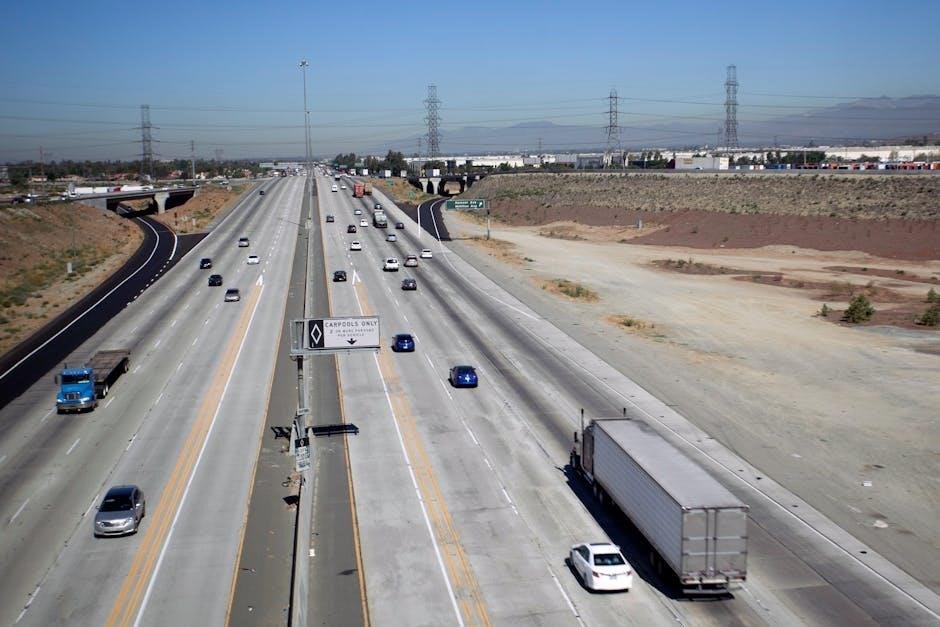
Design and Typography of Guide Signs
Highway and expressway guide signs are designed with standardized fonts, such as Clearview, and color schemes like green, white, and black to ensure readability and consistency nationwide.
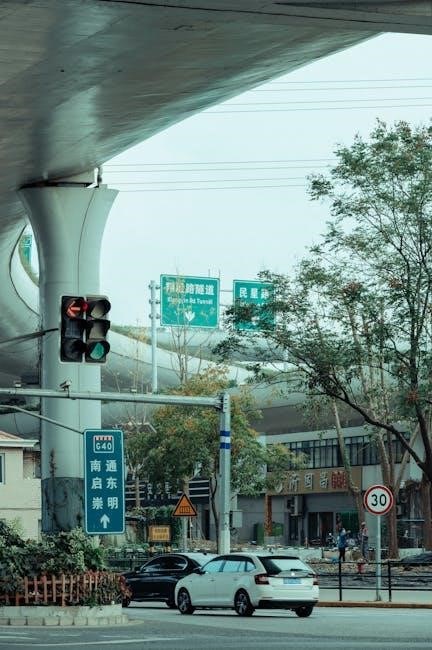
Standardization of Fonts and Colors
Highway and expressway guide signs are standardized using specific fonts, such as the FHWA-approved Clearview typeface, and color schemes like green backgrounds with white text for consistency. This uniformity ensures readability from a distance and compliance with federal regulations like the MUTCD. The use of reflective materials enhances visibility at night, while bold typography and contrasting colors help drivers quickly comprehend information. Such standardization is critical for maintaining clarity and safety across different regions and road types.
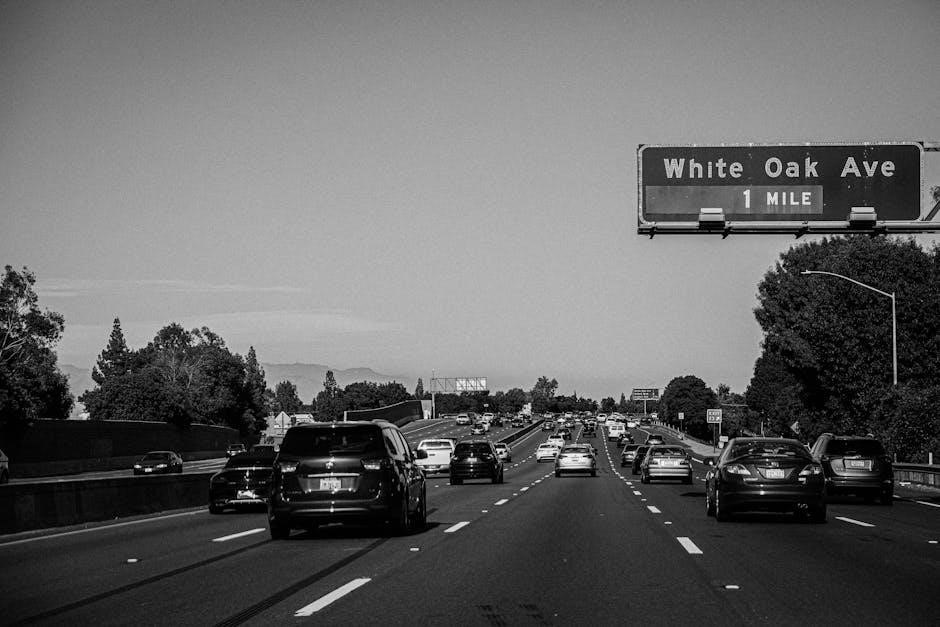
Visibility and Readability Requirements
Highway and expressway guide signs are designed to ensure maximum visibility and readability, even at high speeds or in low-light conditions. Factors like letter height, spacing, and contrasting colors are carefully calibrated to meet federal standards. Reflective materials and angular placement enhance visibility from a distance, while simple, concise messaging reduces driver distraction. These designs aim to provide clear guidance, ensuring drivers can quickly and safely comprehend directional and informational content, especially in fast-paced traffic environments.
Placement and Spacing of Guide Signs
Highway and expressway guide signs are strategically placed to ensure maximum visibility and compliance with traffic laws, spaced appropriately to avoid clutter and enhance driver comprehension.
Strategic Location for Maximum Visibility
Highway and expressway guide signs are positioned at strategic locations to maximize visibility, ensuring drivers can easily see and understand the information. This involves placing signs at appropriate distances before exits, intersections, and key decision points. The placement is carefully planned to account for driver line-of-sight, road curvature, and potential obstructions, ensuring that signs are visible well in advance. Proper positioning enhances readability and reduces driver confusion, contributing to safer and more efficient travel.
Compliance with Traffic Laws and Regulations
Highway and expressway guide signs must comply with traffic laws and regulations to ensure uniformity and safety. The Federal Highway Administration (FHWA) sets standards for sign design, placement, and messaging, adhering to the Manual on Uniform Traffic Control Devices (MUTCD). Compliance ensures signs are legally and functionally consistent, avoiding confusion and enhancing road safety. Regular inspections and updates are conducted to maintain adherence to evolving traffic regulations and infrastructure changes, ensuring guide signs remain relevant and effective for all drivers.
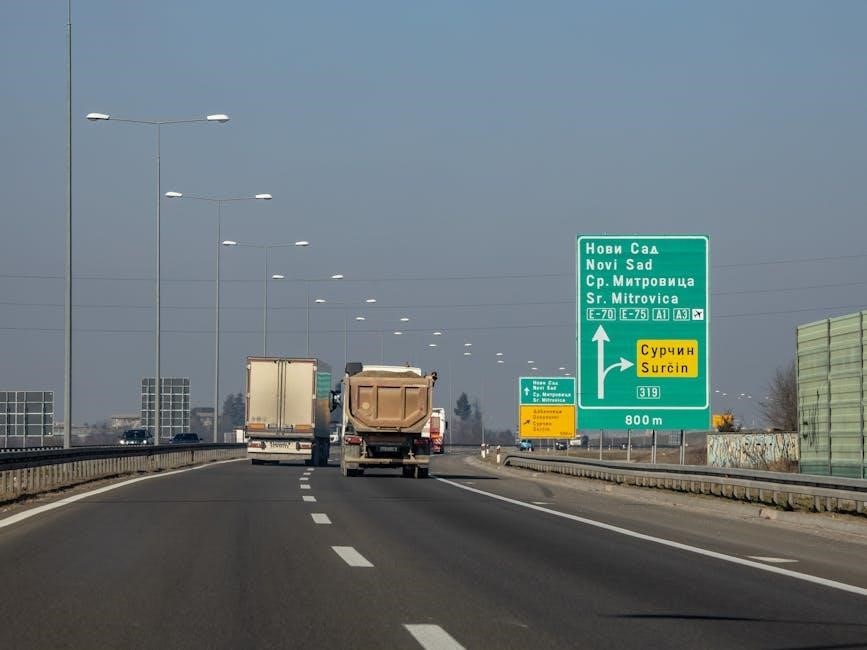
Technological Advancements in Guide Signs
Highway and expressway guide signs are evolving with digital and variable message signs, integrating GPS and real-time traffic updates for smarter, more connected navigation experiences.
Digital and Variable Message Signs
Digital and variable message signs represent a modern leap in guide sign technology, offering real-time updates on traffic conditions, accidents, and construction. These dynamic displays use LED or LCD screens to provide timely information, enhancing driver decision-making. They can be programmed remotely, ensuring rapid responses to changing road conditions. Additionally, they integrate with GPS and navigation systems, offering personalized route suggestions. This technology improves safety and reduces congestion by keeping drivers informed and prepared for the road ahead. Their versatility allows for multilingual support and emergency alerts, making them indispensable in today’s fast-paced transportation networks.

Integration with GPS and Navigation Systems
Highway and expressway guide signs are increasingly integrated with GPS and navigation systems, enhancing accuracy and real-time updates for drivers. This seamless connection provides turn-by-turn directions and alternative routes, reducing confusion and improving journey efficiency. By linking physical signage with digital navigation, drivers receive consistent guidance, ensuring they stay on course. This integration also supports dynamic updates during traffic incidents, offering a reliable and adaptive navigation experience that complements traditional signage, ultimately enhancing safety and reducing travel time. This synergy between physical and digital systems is crucial for modern transportation needs.

Maintenance and Upkeep of Guide Signs
Highway and expressway guide signs require regular inspections and updates to ensure clarity and accuracy, safeguarding driver safety and maintaining efficient navigation on highways and expressways.
Regular Inspection and Repair
Regular inspection and repair of highway and expressway guide signs are essential to ensure they remain clear, legible, and structurally sound. Maintenance teams periodically check for damage, fading, or obstruction, addressing issues promptly to prevent accidents. This process includes cleaning signs, replacing damaged panels, and ensuring proper illumination at night. Timely repairs not only enhance driver safety but also maintain the overall efficiency of traffic flow, ensuring guide signs continue to serve their purpose effectively for all road users.
Updating Signs for Changing Infrastructure
Highway and expressway guide signs must be updated to reflect changes in infrastructure, such as new road constructions, renamed streets, or altered traffic patterns. This ensures accuracy and prevents confusion among drivers. Updates often involve replacing or modifying existing signs to incorporate new information, such as updated exit numbers or alternate routes. Additionally, advancements in digital technology allow for real-time updates to variable message signs, providing drivers with the most current guidance, enhancing safety, and improving overall navigation efficiency on the road.
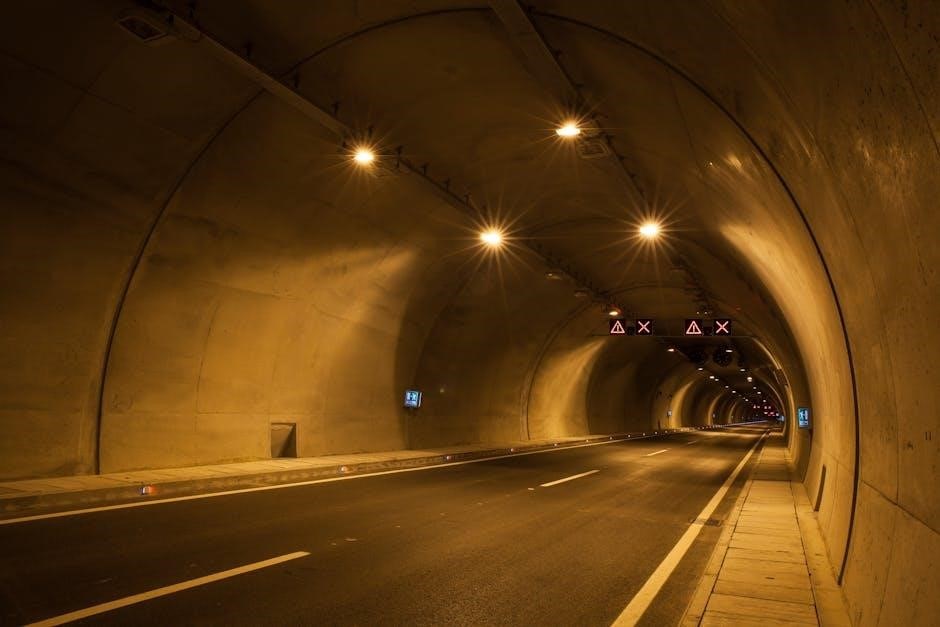
Highway and expressway guide signs are vital for safe navigation, enhancing driver safety and efficiency. Their evolution with technology ensures continued relevance in modern transportation systems.
Future Trends in Guide Sign Technology
Future trends in guide sign technology include the integration of digital and variable message signs, enabling real-time updates for traffic, accidents, and weather conditions.
These signs will leverage GPS and data analytics to provide personalized route suggestions, enhancing navigation efficiency.
Additionally, advancements in AI and machine learning will improve predictive maintenance and energy efficiency, ensuring optimal performance.
Solar-powered signs and eco-friendly materials are expected to become standard, aligning with sustainability goals.
Overall, these innovations will redefine how guide signs contribute to smarter, safer, and more efficient transportation systems.
The Role of Guide Signs in Modern Transportation
Highway and expressway guide signs play a vital role in modern transportation by ensuring safe and efficient navigation.
They provide clear directions, reducing driver confusion and minimizing travel time.
These signs are essential for maintaining traffic flow, preventing accidents, and guiding motorists through complex road networks.
With advancements in technology, guide signs now integrate with GPS and real-time data to offer dynamic updates.
Their role extends to enhancing overall transportation infrastructure, making them indispensable in today’s fast-paced world.
